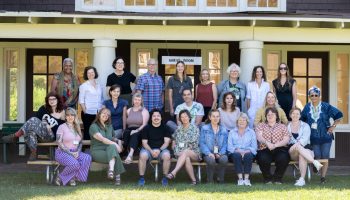
Julia Weber
Staff Writer
If you’ve walked by Strohl Art Center this summer — perhaps to see one of Chautauqua Visual Arts’ many indoor exhibitions — you may have noticed the Melvin Johnson Sculpture Garden, situated near the building, bringing art to the outdoors. On view through Thursday, this year’s sculpture garden exhibition brings artists Coral Lambert and Paul Higham’s works together for a conversation about how humans understand the world around them.
Lambert said her artistic practice is an investigation into process, material and site. Her work responds to the natural world, considering materiality and landscape in her pieces. By combining geometric forms like fabricated and construction-welded steel with the organic forms of cast metal, Lambert juxtaposes forms to create contrast in her work.

She said she sees her sculptures as having an idea of balance — there is a fine line between them looking like something that is captured in a cage, versus being presented to the viewer.
“There’s this sort of dichotomy between something being trapped or something being released and supported,” she said.
With a background in printmaking, Lambert said she found parallels between both mediums that informed her approach to sculpture. For her, the similarity lies in the process. Printmaking and sculpture casting alike require the artist to create a mold or template first without being able to see the outcome.
“Within that reveal, you have all of the marks of the process,” she said. “If you look at my sculpture, you’ll see the marks of the molten metal, you’ll be able to see where the metal cooled, where it changed, so you’re kind of capturing it in time.”
“Over 30 years of being a sculptor, that’s what I really love about the process – when you let that take over, and you gently train it to do what you want it to do,” she said. “Especially with the organic forms, allowing some of the scars of the process becomes a metaphor for the scars that we might make on the Earth.”

Meanwhile, Higham’s work is a response to technology and an exploration of how individuals can harness and use these tools to create art. Using rapid prototyping technology and computer numerical control technology, or CNC, Higham’s sculptures exhibit data in tangible forms, bringing a new perspective to the massive amounts of information available at our fingertips.
“Nowadays, data is considered to be a very real integral part of social flux,” Higham said. “What I was concerned with (in the making of the work) is taking pieces of data like the stock exchange, Dow Jones index, and crafting them into 3D representations, often very simple forms, representing some kind of gradual change or some kind of catastrophic change,” he said.
In his work, he said he aims to “visualize the shape and form, the flux of changes in society.”
Higham began his career in sculpture in the 1970s amid the Fluxus movement, which aimed to deprioritize the role of the object in sculpture in favor of using sculpture as representation. Higham, on the other hand, said he felt it more important to locate the object as “an autonomous emergent object only conformed to its own self-organizing principles.”
As soon as they became more widely accessible to the public in the 1970s and 1980s, Higham began working with computers. For him, the ability to engage with these methods of computational technologies proved foundational to his artistic practice.

“This is important for everybody, really, who was waking up to what was possible with computation, with coding, with the idea of what I would call an emergent form of art,” he said.
For Higham, these sculptures provide a fixed portrayal of data and the systems which underpin our society. Through these representations, the viewer can then visualize changes and the system becomes transparent.
“You can see — in real time — the revelation of what is going on within (the) population or you can see what’s going on in a system,” he said. “The system can become transparent.”
In conversation, Lambert’s and Higham’s works construct dialogues and question how we, as viewers and as humans, understand and interpret the world around us, whether it be the natural world, which has existed, morphed and changed over millennia or the vast amounts of data we parse through every minute.




